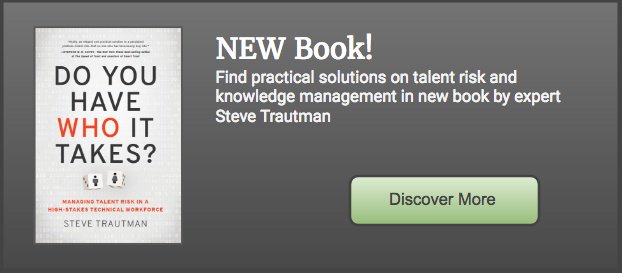Successful knowledge transfer is a process—one with definable steps, practical tools, and measurable outcomes. A new manufacturing client prompted the quick Q&A below that shows why knowledge transfer does not “just happen” and why it’s utterly practical rather than theoretical.
A few months back, my firm was working with a team of senior leaders who are collectively responsible for building a $400 million industrial rig. Some of the leaders are in the U.S. where the project was designed; others are offshore where the project will be built.
The team needs to reduce their risk because too many of their leaders are new to this type of construction project and there are many unanswered questions and unclear expectations as they kick off the 3-year effort. In presenting my company’s 3-step Talent Risk Management Solution and explaining how we help an organization’s experts to transfer their knowledge to coworkers, we heard some familiar concerns that I thought I’d address here in the blog.
Arbitrary
Q: This feels pretty arbitrary. Who set the bar and said that I am “at risk?” I’m only moderately sure that our company’s so-called “experts” are even clear about what they want!
A: As I’ve said many times, you can’t ask someone to transfer knowledge until you know that the right person is transferring the right knowledge. Using a talent risk assessment tool like our Knowledge Silo Matrix (KSM) ensures that the right person(s) will be designated to mentor. Filling out a Skill Development Plan (SDP) makes sure that the right knowledge is targeted for transfer to those who lack it. The process reveals critical knowledge gaps in a team and forces the experts/mentors to be very clear about expectations for the work, so their resulting knowledge transfer sessions with coworkers/apprentices are more fruitful. The Skill Development Plan is customized for each individual apprentice in a way that is targeted to the current situation. The plan is customized relative to the:
- risk that was identified in the KSM
- existing workload of the team
- prior experience of the apprentice
- availability of the mentor; and the
- availability of formal training or other resources
In this way it is the opposite of arbitrary. It is completely personalized and relevant. Also, why an employee is marked as an “apprentice” becomes very clear when we (or their manager) sit down and customize an SDP for them. The employee can look at each line item in the plan and see what knowledge gaps they have and what they are doing differently than their mentor expects.
Academic
Q: I’m also worried that this is all very academic. My job is hands-on, technical, and constantly changing. How can the knowledge transfer process respond to such a dynamic environment?
A: The knowledge transfer process is intended to happen on the job and in the course of doing regular daily work. It was developed and refined in real-life, heated business environments—not in academic ones. The training that apprentices receive is “just in time” and customized to the appropriate place in any project cycle. Formal training does not typically have this kind of flexibility; it often has to speak to a much broader timeline and cover a more generalized curriculum.
Also, the test questions that we use with the SPD to ensure that the wisdom and tacit knowledge are transferred are atypical of most “certifications.” We’re not only asking about the “steps in the process,” we’re also asking much broader questions that get at, for example, the problems to avoid, political issues, opportunities for innovation, escalation paths, and rules. Your expert chooses the test questions for each skill (with our guidance about types of questions that will get at deeper wisdom), and then the mentor-apprentice discussions around the test questions during their sessions ensure that the knowledge transfer is extremely practical and targeted, not academic.
Conclusion
Knowledge transfer is a practical, on-the-job process that uses clear steps and tools to reduce the subjectivity and remove the arbitrary from the task of getting a workforce prepared and productive. Clarify this with your teams and use these answers to dispel concerns.

